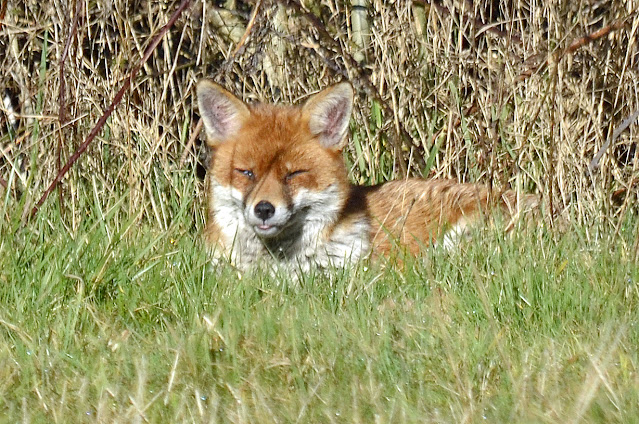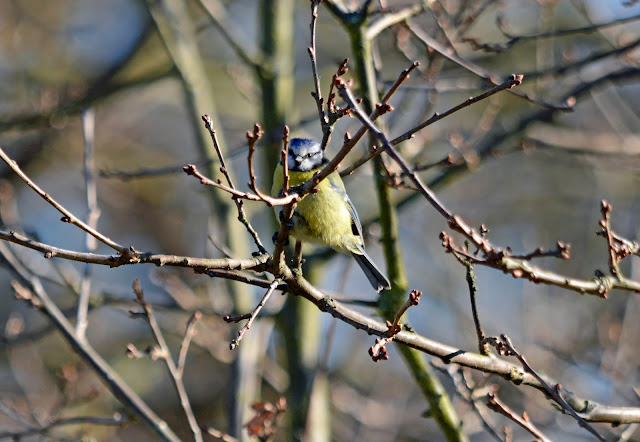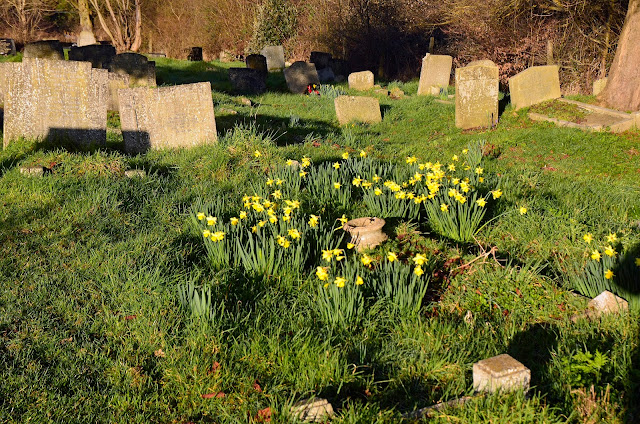Date: 26th February 2021
Time: from 7:45 a.m.
Weather: dry, sunny, light wind, 3°C
to 8°C
What an excellent visit today!
With the lengthening days now, this was my earliest start to a visit since last summer. It was a
beautiful sunny spring-like morning with hardly any wind although early on
there was still some remnant ground frost to remind me that winter hasn’t quite
left us yet.
This morning, I recorded 24
bird species, including 2 additions to my site list for the year, 3
mammal species and an identified bumblebee species …. plus a rather
annoying flying drone! On 5th February 2021, I recorded 21 bird species
and these totals during February are my highest since last spring and summer.
The 2 additions to my site list for the year were Blackcap and Canada Goose.
The
Blackcap record was also my first anywhere for 2021 and totally
unexpected. I generally record my first Chiffchaff of the year (mid to
late March) before Blackcap (late March to early April .... 26th March last year) but both these
species are now increasingly being seen during the winter months due to our
warming climate. Therefore it is difficult to determine if any sightings of
either species in February are of wintering birds or very early returning summer
migrants.
Whichever is this case, it was wonderful to hear a singing male Blackcap in the extreme south west of the site where it borders Pound Lane. I listened to it for some 5 minutes but it failed to emerge from the trees/hedges where it was singing from. Despite a brief play of its song on my Collins Bird Guide app on my mobile phone, I was unable to tempt him in to view.
As on my last visit on 22nd February 2021, woodpecker
activity was very noticeable this morning and I saw both Great
Spotted Woodpecker and Green Woodpecker.
Once again, I heard and saw a male Great
Spotted Woodpecker “drumming” at the top of the spire of St. Nicholas
Church. After about 5 minutes, he started calling very excitedly and the reason
quickly became clear as a female Great Spotted Woodpecker flew
in to an adjacent tree.
As I arrived at my access to the site by Larkins
Tyres, I immediately saw a Green Woodpecker close by in the
scrub area. Whilst watching the Reeves’ Muntjac (see below), there was also a
loudly calling bird in the area of woodland between the clearing and the
Laindon Park School playing field. As I approached the eastern end of the
cemetery, I heard a calling Green Woodpecker again and this
time it emerged and flew up the cemetery towards the trees around the church. I
am not sure if this was the same bird throughout or different individuals.
It was also a good visit for finches although I didn’t
actually see any! There was a singing male Chaffinch in the
scrub area by Larkins Tyres, a calling male Greenfinch in the
same area and another calling in the extreme south west of the site where
it borders Pound Lane plus several fly-over calling Goldfinches.
The area behind Larkins Tyres also provided the
sight of a Sparrowhawk rapidly flying through.
Bird song continues to increase as
spring approaches and, in addition to the Blackcap and
the Chaffinch, I recorded Song Thrush, Wren, Robin, Dunnock, Great
Tit and Blue Tit. There was also noticeable evidence
of pre-breeding activity with much chasing amongst the Blue Tits,
display flights from a few of the Woodpigeons and wing-flicking and chasing
of Dunnocks.
Ah, the xxx rated sex life of
the Dunnock! …. “Google” it, this is a family-orientated blog!
However, one website comments …. “The Dunnock has a most racy sex life which if
replicated amongst the good folk of a country parish would be deemed as quite
scandalous.”
With regard to mammals, it was also an excellent
visit which started off with 3 Reeves’ Muntjacs followed by
3 Red Foxes.
As I walked along the track from Larkins Tyres, I
quickly glimpsed a Reeves’ Muntjac through the trees as it
walked across Laindon Park School playing field.
When I reached the clearing, I then took the short track through the
woodland to the fencing that provides a watchpoint to scan the field and the
trees, hedges and scrub bordering it.
From here, I saw 2 Reeves’
Muntjacs emerge on the far side although they then moved off in
different directions and disappeared for several minutes. The first then
re-emerged much closer to my left followed shortly afterwards by the second
which re-emerged much closer to my right. Both again disappeared from my view
but I did see what was probably the second animal again walking slowly through the
trees immediately behind me. I managed to get photos of both these Reeves’
Muntjacs.
After a walk around the site, I
returned to this watchpoint and immediately saw a Red Fox lying
in the sun straight ahead of me at the edge of the tree/hedge/scrub line. After a
few minutes, it quickly sprang up and I thought it had either seen or heard me.
However, what caused it to panic was another Red Fox appearing
from behind it. The first animal quickly ran off across the field and
disappeared from view whilst the second animal stood momentarily in the sun before it
turned around and disappeared from where it had come from.
I then looked to my left only to
see a third Red Fox also lying in the sun but much closer to
me. It was quite obvious that it had seen me but the pleasure of sitting in the
warm sun clearly outweighed any desire to run off. In fact, this
particular Red Fox was so relaxed that it finally curled up
and went to sleep.
I managed to get photos of all 3
of these Red Foxes.
I also saw 3 Grey Squirrels: 1 in the
same area as the Reeves’ Muntjacs and the Red Foxes, 1 in the south west
of the site where it borders Pound Lane and 1 along Church Hill.
Species recorded during this visit were as follows
(heard only records in italics):
Here are some photos from my visit:
Photo: Red Fox
Photo: Red Fox
Photo: Red Fox
Photo: Red Fox
Photo: Red Fox
Photo: Red Fox
Photo: Reeves' Muntjac
Photo: Reeves' Muntjac
Photo: Reeves' Muntjac
Photo: Robin
Photo: Robin
Photo: Dunnock
Photo: Dunnock
Photo: Blue Tit
Photo: Song Thrush
Photo: Great Spotted Woodpecker
Photo: Great Spotted Woodpecker
Photo: Magpie
Photo: Collared Dove
Photo: Collared Dove
Photo: Bumblebee species
Photo: Bumblebee species






































No comments:
Post a Comment
If you feel like commenting on my blog, you can contact me by completing the comment form below. I will respond to all comments and enquiries and constructive criticism will always be welcomed.